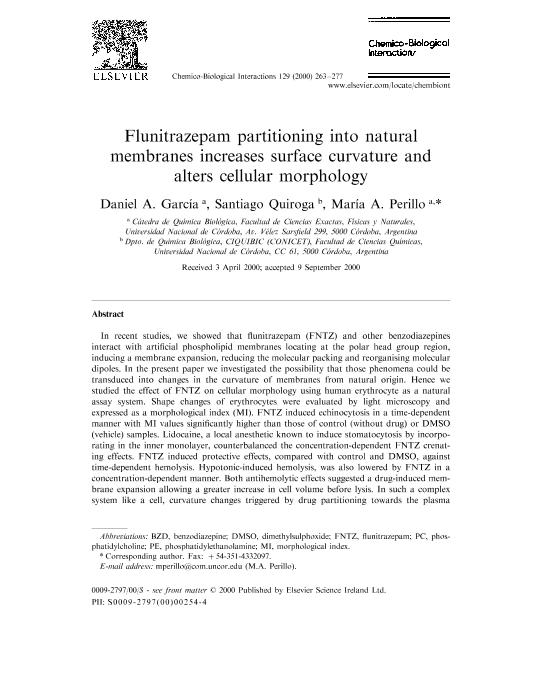Mostrar el registro sencillo del ítem
dc.contributor.author
Garcia, Daniel Asmed

dc.contributor.author
Quiroga, Santiago

dc.contributor.author
Perillo, Maria Angelica

dc.date.available
2018-11-15T14:51:46Z
dc.date.issued
2000-12-15
dc.identifier.citation
Garcia, Daniel Asmed; Quiroga, Santiago; Perillo, Maria Angelica; Flunitrazepam partitioning into natural membranes increases surface curvature and alters cellular morphology; Elsevier Ireland; Chemico-biological Interactions; 129; 3; 15-12-2000; 263-277
dc.identifier.issn
0009-2797
dc.identifier.uri
http://hdl.handle.net/11336/64524
dc.description.abstract
In recent studies, we showed that flunitrazepam (FNTZ) and other benzodiazepines interact with artificial phospholipid membranes locating at the polar head group region, inducing a membrane expansion, reducing the molecular packing and reorganising molecular dipoles. In the present paper we investigated the possibility that those phenomena could be transduced into changes in the curvature of membranes from natural origin. Hence we studied the effect of FNTZ on cellular morphology using human erythrocyte as a natural assay system. Shape changes of erythrocytes were evaluated by light microscopy and expressed as a morphological index (MI). FNTZ induced echinocytosis in a time-dependent manner with MI values significantly higher than those of control (without drug) or DMSO (vehicle) samples. Lidocaine, a local anesthetic known to induce stomatocytosis by incorporating in the inner monolayer, counterbalanced the concentration-dependent FNTZ crenating effects. FNTZ induced protective effects, compared with control and DMSO, against time-dependent hemolysis. Hypotonic-induced hemolysis, was also lowered by FNTZ in a concentration-dependent manner. Both antihemolytic effects suggested a drug-induced membrane expansion allowing a greater increase in cell volume before lysis. In such a complex system like a cell, curvature changes triggered by drug partitioning towards the plasma membrane, might be an indirect effect exerted through modifications of ionic-gradients or by affecting cytoskeleton-membrane linkage. In spite of that, the curvature changes can be interpreted as a mechanism suitable to relieve the tension generated initially by drug incorporation into the bilayer and may be the resultant of the dynamic interactions of many molecular fluxes leading to satisfy the spontaneous membrane curvature. © 2000 Published by Elsevier Science Ireland Ltd.
dc.format
application/pdf
dc.language.iso
eng
dc.publisher
Elsevier Ireland

dc.rights
info:eu-repo/semantics/openAccess
dc.rights.uri
https://creativecommons.org/licenses/by-nc-sa/2.5/ar/
dc.subject
Anti-Hemolytic Effect
dc.subject
Benzodiazepine
dc.subject
Erythrocyte
dc.subject
Flunitrazepam
dc.subject
Lidocaine
dc.subject
Membrane Expansion
dc.subject.classification
Otras Ciencias Biológicas

dc.subject.classification
Ciencias Biológicas

dc.subject.classification
CIENCIAS NATURALES Y EXACTAS

dc.title
Flunitrazepam partitioning into natural membranes increases surface curvature and alters cellular morphology
dc.type
info:eu-repo/semantics/article
dc.type
info:ar-repo/semantics/artículo
dc.type
info:eu-repo/semantics/publishedVersion
dc.date.updated
2018-11-12T13:46:06Z
dc.journal.volume
129
dc.journal.number
3
dc.journal.pagination
263-277
dc.journal.pais
Irlanda

dc.journal.ciudad
Limerick
dc.description.fil
Fil: Garcia, Daniel Asmed. Consejo Nacional de Investigaciones Científicas y Técnicas. Centro Científico Tecnológico Conicet - Córdoba; Argentina. Universidad Nacional de Córdoba. Facultad de Ciencias Exactas, Físicas y Naturales. Departamento de Química. Cátedra de Química Biológica; Argentina
dc.description.fil
Fil: Quiroga, Santiago. Consejo Nacional de Investigaciones Científicas y Técnicas. Centro Científico Tecnológico Conicet - Córdoba. Centro de Investigaciones en Química Biológica de Córdoba. Universidad Nacional de Córdoba. Facultad de Ciencias Químicas. Centro de Investigaciones en Química Biológica de Córdoba; Argentina
dc.description.fil
Fil: Perillo, Maria Angelica. Consejo Nacional de Investigaciones Científicas y Técnicas. Centro Científico Tecnológico Conicet - Córdoba; Argentina. Universidad Nacional de Córdoba. Facultad de Ciencias Exactas, Físicas y Naturales. Departamento de Química. Cátedra de Química Biológica; Argentina
dc.journal.title
Chemico-biological Interactions

dc.relation.alternativeid
info:eu-repo/semantics/altIdentifier/url/https://www.sciencedirect.com/science/article/pii/S0009279700002544
dc.relation.alternativeid
info:eu-repo/semantics/altIdentifier/doi/https://dx.doi.org/10.1016/S0009-2797(00)00254-4
Archivos asociados
